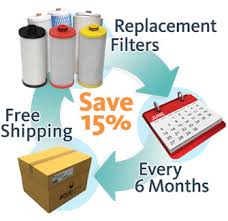When it comes to the bestseller list, Amazon is a reasonable place to browse due to their vast pool of consumers. Currently, Amazon's top-l selling water pitcher filtration systems are, in order of popularity, the PUR 18-cup pitcher, the Mavea Elemaris 9-cup pitcher, the PUR 7-cup pitcher and the Brita Atlantis 6-cup pitcher. Each system received 4.5 stars by Amazon voters. However, the PUR 18-cup received 1,149 votes whereas the Brita received only 199 votes. As previously mentioned, aesthetic choices as well as appropriate size are subjective and a personal consumer choice, so the model is essentially a wash. The brands, however, have different strategies for getting the job of purifying the user's water done. The fact that all of the systems received 4.5 stars, regardless of the number of voters, makes it more difficult to point to a clear-cut winner.
For information on the top brands and how their pitchers function, an informative site is filterfast.com. Filterfast.com sells every type of filter imaginable and also provides ample information and research data on various models. Their top three filter brands, as with most sites, are Brita, Mavea and PUR. To choose the best water pitcher filtration system, it can be helpful to look at each system and how they work.
Brita is the brand that consumers in the United States purchase 70% of the time. It is extremely popular and there are sixteen unique models to choose from, depending on the buyer's personal needs and preferences. The Brita utilizes activated carbon and ion exchange resin to filter impurities and reduce metals. Brita smart pitchers now come with a life indicator that serves as a reminder to change the filter.
Mavea was actually started by the original CEO of Brita. Once Brita was sold to Clorox, he created Mavea. Although Mavea doesn't offer as many styles as Brita, they claim to be a superior system. Their pitchers have a unique micromesh filter that supposedly block more contaminants than Brita's filters.
PUR pitchers are "certified" to cut three times more contaminants than other water pitcher filtration systems. It does this in two stages. PUR utilizes activated carbon as well as heat-treated coconut shells to further absorb and trap contaminants. PUR pitchers can also be purchased with a filter life indication system.
Although the bestseller list along with information about how each system works can be useful, it can also be beneficial to look at research conducted on the available systems out there. Good Housekeeping recently teamed up with the Arizona Laboratory for Emerging Contaminants to test water filtration systems against 15 typical contaminants. They tested each filtration system with the typical 40 gallons for a filter's lifetime, and tested every pitcher four times to catalogue their effectiveness along the way. According to their research on PUR and Brita, the PUR system removed 71% of all drugs and 80% of contaminants compared to Brita's removal of 60% of contaminants.
Further, according to research compiled by waterfiltercomparisions.com, the PUR system reduced 13 contaminants compared to Mavea's eight and Brita's five. Their research also puts the PUR system at the top in performance of water pitcher filtration systems.
PUR and Brita water pitcher filtration systems tend to run around the same price range, while Mavea tends to cost anywhere from $5 to $7 more than the comparable models of PUR and Brita. On Amazon, the standard seven-cup CR-6000C PUR pitcher currently costs $18.72, the Brita 10-cup everyday pitcher sells for $22.97, and the Mavea 9-cup Elemaris costs $32, alternatively go for an Aquasana deal. As previously mentioned, each brand has larger as well as slimmer sizes available, which can slightly alter the price point. Even in the price matchup, PUR appears to come out on top as well.
The bottom line is that PUR's price is comparable to Brita's and is less than Mavea's price point; more Amazon buyer's choose PUR over Brita and Mavea; and multiple research sources indicate that PUR eliminates more contaminants than other leading water pitcher filtration systems. The questions remains, which model is more appropriate for the individual buyer? That option is up to the consumer, but for the money and quality, PUR seems to be the best water pitcher filtration system on the current market.



